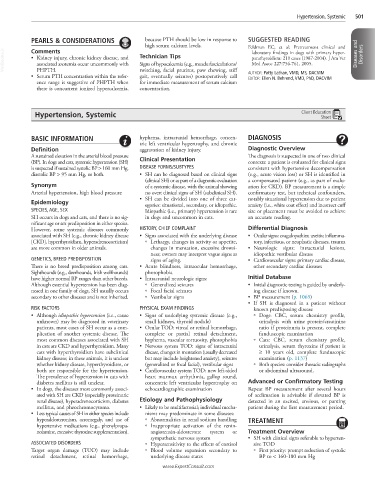Page 1018 - Cote clinical veterinary advisor dogs and cats 4th
P. 1018
Hypertension, Systemic 501
PEARLS & CONSIDERATIONS because PTH should be low in response to SUGGESTED READING
high serum calcium levels. Feldman EC, et al: Pretreatment clinical and
Comments
VetBooks.ir • Kidney injury, chronic kidney disease, and Technician Tips parathyroidism: 210 cases (1987-2004). J Am Vet Diseases and Disorders
laboratory findings in dogs with primary hyper-
Signs of hypocalcemia (e.g., muscle fasciculations/
associated azotemia occur uncommonly with
Med Assoc 227:756-761, 2005.
PHPTH.
• Serum PTH concentration within the refer- twitching, facial pruritus, paw chewing, stiff AUTHOR: Patty Lathan, VMD, MS, DACVIM
gait, eventually seizures) postoperatively call
EDITOR: Ellen N. Behrend, VMD, PhD, DACVIM
ence range is suggestive of PHPTH when for immediate measurement of serum calcium
there is concurrent ionized hypercalcemia, concentration.
Hypertension, Systemic Client Education
Sheet
BASIC INFORMATION hyphema, intracranial hemorrhage, concen- DIAGNOSIS
tric left ventricular hypertrophy, and chronic
Definition aggravation of kidney injury. Diagnostic Overview
A sustained elevation in the arterial blood pressure Clinical Presentation The diagnosis is suspected in one of two clinical
(BP). In dogs and cats, systemic hypertension (SH) contexts: a patient is evaluated for clinical signs
is suspected if sustained systolic BP > 160 mm Hg, DISEASE FORMS/SUBTYPES consistent with hypertensive decompensation
diastolic BP > 95 mm Hg, or both. • SH can be diagnosed based on clinical signs (e.g., acute vision loss) or SH is identified in
(clinical SH) or as part of a diagnostic evaluation a compensated patient (e.g., as part of evalu-
Synonym of a systemic disease, with the animal showing ation for CKD). BP measurement is a simple
Arterial hypertension, high blood pressure no overt clinical signs of SH (subclinical SH). confirmatory test, but technical confounders,
• SH can be divided into one of three cat- notably situational hypertension due to patient
Epidemiology egories: situational, secondary, or idiopathic. anxiety (i.e., white coat effect) and incorrect cuff
SPECIES, AGE, SEX Idiopathic (i.e., primary) hypertension is rare size or placement must be avoided to achieve
SH occurs in dogs and cats, and there is no sig- in dogs and uncommon in cats. an accurate reading.
nificant age or sex predisposition in either species.
However, some systemic diseases commonly HISTORY, CHIEF COMPLAINT Differential Diagnosis
associated with SH (e.g., chronic kidney disease • Signs associated with the underlying disease • Ocular signs: coagulopathies; uveitis; inflamma-
[CKD], hyperthyroidism, hyperadrenocorticism) ○ Lethargy, changes in activity or appetite, tory, infectious, or neoplastic diseases, trauma
are more common in older animals. changes in mentation, excessive drowsi- • Neurologic signs: intracranial lesions,
ness; owners may interpret vague signs as idiopathic vestibular disease
GENETICS, BREED PREDISPOSITION signs of aging. • Cardiovascular signs: primary cardiac disease,
There is no breed predisposition among cats. • Acute blindness, intraocular hemorrhage, other secondary cardiac diseases
Sighthounds (e.g., deerhounds, Irish wolfhounds) photophobia
have higher normal BP ranges than other breeds. • Intracranial neurologic signs: Initial Database
Although essential hypertension has been diag- ○ Generalized seizures • Initial diagnostic testing is guided by underly-
nosed in one family of dogs, SH usually occurs ○ Focal facial seizures ing disease if known.
secondary to other diseases and is not inherited. ○ Vestibular signs • BP measurement (p. 1065)
• If SH is diagnosed in a patient without
RISK FACTORS PHYSICAL EXAM FINDINGS known predisposing disease
• Although idiopathic hypertension (i.e., cause • Signs of underlying systemic disease (e.g., ○ Dogs: CBC, serum chemistry profile,
unknown) may be diagnosed in veterinary small kidneys, thyroid nodule) urinalysis with urine protein/creatinine
patients, most cases of SH occur as a com- • Ocular TOD: vitreal or retinal hemorrhage, ratio if proteinuria is present, complete
plication of another systemic disease. The complete or partial retinal detachment, funduscopic examination
most common diseases associated with SH hyphema, vascular tortuosity, photophobia ○ Cats: CBC, serum chemistry profile,
in cats are CKD and hyperthyroidism. Many • Nervous system TOD: signs of intracranial urinalysis, serum thyroxine if patient is
cats with hyperthyroidism have subclinical disease, changes in mentation (usually decreased ≥ 10 years old, complete funduscopic
kidney disease; in these animals, it is unclear but may include heightened anxiety), seizures examination (p. 1137)
whether kidney disease, hyperthyroidism, or (generalized or focal facial), vestibular signs ○ Both species: consider thoracic radiographs
both are responsible for the hypertension. • Cardiovascular system TOD: new left-sided or abdominal ultrasound.
The prevalence of hypertension in cats with heart murmur, arrhythmia, gallop sound,
diabetes mellitus is still unclear. concentric left ventricular hypertrophy on Advanced or Confirmatory Testing
• In dogs, the diseases most commonly associ- echocardiographic examination Repeat BP measurement after several hours
ated with SH are CKD (especially proteinuric of acclimation is advisable if elevated BP is
renal disease), hyperadrenocorticism, diabetes Etiology and Pathophysiology detected in an excited, anxious, or panting
mellitus, and pheochromocytoma. • Likely to be multifactorial; individual mecha- patient during the first measurement period.
• Less typical causes of SH in either species include nisms may predominate in some diseases:
hyperaldosteronism, acromegaly, and use of ○ Abnormalities in renal sodium handling TREATMENT
hypertensive medications (e.g., phenylpropa- ○ Inappropriate activation of the renin-
nolamine, excessive thyroxine supplementation). angiotensin-aldosterone system or Treatment Overview
sympathetic nervous system • SH with clinical signs referable to hyperten-
ASSOCIATED DISORDERS ○ Hypersensitivity to the effects of cortisol sive TOD
Target organ damage (TOD) may include ○ Blood volume expansion secondary to ○ First priority: prompt reduction of systolic
retinal detachment, retinal hemorrhage, underlying disease states BP to < 160-180 mm Hg
www.ExpertConsult.com

